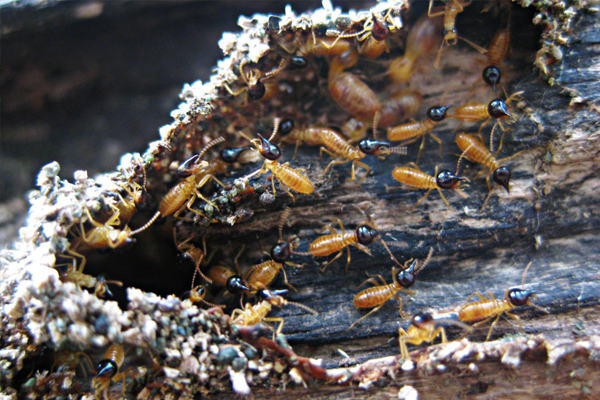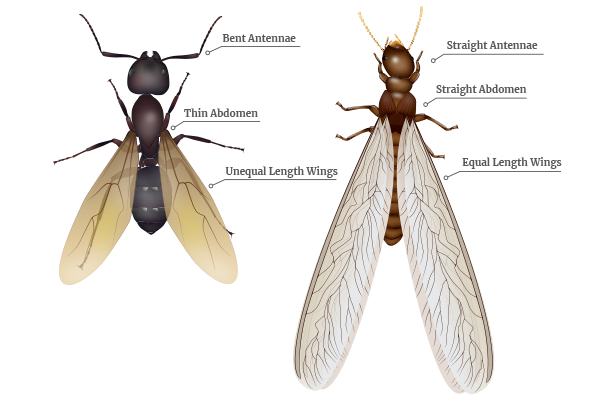
What do termites look like?
Eastern subterranean termites live in large underground colonies that contain thousands of members. While all members of the colony work together to ensure the success of the colony, there are three different groups (or castes). What they look like and what their function is depends on which group they belong to.
Termite Castes:
- Workers: Making up the largest portion of the termite colony, termite workers have soft creamy white bodies. They are wingless, blind, and grow up to ¼ of an inch in length. The job of termite workers is to feed the colony. Termites consume cellulose, a material found in wood. In nature, they break down rotting or decaying logs but inside homes and businesses they seek out water damaged wood and will move on to sound wood if necessary. If a structure is dealing with a termite infestation, you may notice the workers in the soil around the foundation or find their mud tubes extending out of the ground onto the structure.
- Soldiers: Similar in appearance to the workers, soldiers are a bit larger in size and have an elongated yellow head, large strong jaws, and short legs. As their name suggests, termite workers are tasked with defending the colony against threats.
- Reproductive Members: Reproductives are the first king and queen of a termite colony. Dark in color, they have wings and may reach ½ inch in length. They are the winged termites seen during a termite swarm (inside or outside. During termite swarming season, reproductive will leave an existing colony in order to find a mate and establish a new colony.
How do you tell the difference between flying ants and termite swarmers?
Carpenter ants and termites are often mistaken for one another. That’s because they have similar behaviors (both tunnel in wood, both cause damage to structures, both swarm in order to start new colonies, etc.). If you’ve notice a swarm of flying insects inside your structure or outside and are wondering what type of insect it is, see the differences between winged termites and flying ants in the illustration below.

Where do termites nest?
Eastern subterranean termites nest below the frost line underground but will also nest in wood that is wet inside. Often in homes and businesses, termite nests near water leaks or inside damaged wood.
What are the signs of a termite problem?
Unlike ants and other bugs, termites are masters at avoiding detection. You may not even realize there is a termite infestation in your home or business until they’ve been there for an extended period of time. Having a good understanding of what the signs of a termite infestation are will allow you to seek help for an infestation sooner than later, helping to limit their damages. Signs of a termite infestation include:
- Termite mud tubes: You might compare termite mud tubes to a highway. They allow termites to travel from their underground colonies to food sources without being exposed to air. Mud tubes are often found on foundations and exteriors but could be discovered inside too.
- Termite swarms: In the spring reproductives will fly from a mature colony in order to mate and in the process create a termite “swarm”. Witnessing a termite swarm is a good indication that a termite colony is located near your structure. Unfortunately, if a termite swarm occurs inside, you definitely have a problem.
- Piles of wings: You may not witness a termite swarm but if you find piles of discarded wings on your window sills, floor, or outside then you can be sure one occurred and that there is a termite colony nearby or worse, inside your home or business.
- Termite damage: Discovering wood in or around your home that is splintered, weathered, or that has small holes on its surface is an indication of termite damage as is floor that feels “spongy”, hollow sounding walls, and door and windows that no longer open or close properly.
Are termites dangerous?
While termites do not pose a threat to health, they are capable of inflicting significant and costly damages to residential dwellings and commercial facilities.
How do I get rid of termites?
In order to get rid of termites, you must eliminate the entire colony. Should the queen remain, the colony will repopulate. At Superior Pest Solutions, we provide liquid termite treatments using Termidor. When you contact us for termite control, we’ll start with a thorough inspection to confirm the presence of termites, evaluate the severity of the infestation, and determine what conditions in and around your property are conducive to termite activity. Based on our findings, we’ll develop a plan, provide you with the cost of the termite treatment, and then get to work exterminating termites. If you own a home or business in Southern New Jersey and are concerned about termites, call the company that has been eliminating termites in NJ for over 30 years- contact Superior.
How can I prevent a termite infestation?
To prevent a termite infestation in your home or facility, we recommend fixing or removing the conditions that attract them in the first place. Here are a few prevention tips that our termite control pros have put together.
- Reduce moisture levels inside.
- Properly ventilate areas prone to moisture.
- Fix leaking pipes and appliances that could cause water damage.
- Remove and/or replace wood that has been damaged by water.
- Limit soil to wood contact outside the structure.
- Remove rotting logs, piles of leaves, and other organic debris.
- Unclog gutters and make sure that gutters are directing water away from the structure and not pooling on the ground.
